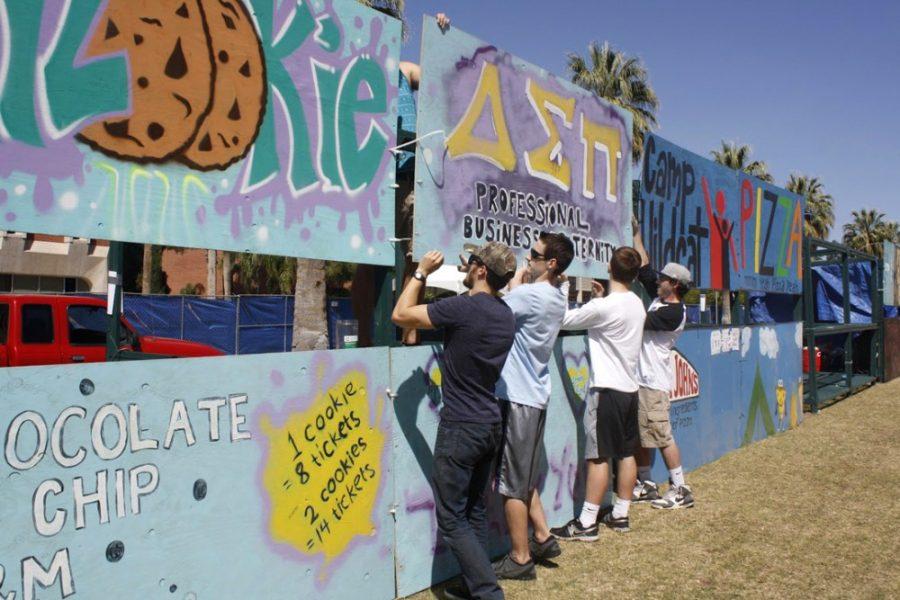Spring Fling, a student-run carnival led by eight student directors along with hundreds of student volunteers, has a budget each year of approximately $190,000 from the Associated Students of the University of Arizona.
While the directors try to keep their expenses around $165,000, according to Spring Fling Executive Director Chance Stewart, a business economics junior, the budget gets broken down roughly the same way each year.
Field operations accounts for about 70 percent of the budget, or roughly $133,000. This includes things like fencing, restrooms and club booths.
Josler Tudisco, director of marketing and a political science and psychology junior, said most Spring Fling expenses fall under field operations.
RELATED: Carnival rides big draw at Spring Fling
“It’s everything you could think of, from bathrooms to rides,” Tudisco said. “That’s why they get the biggest chunk of the budget.”
The next largest portion of the budget goes to marketing, Tudisco’s area. Marketing gets about 13 percent of the budget, or $24,700, and includes radio advertisements, TV commercials, billboards and any other advertising. However, Tudisco said he doesn’t always use the full amount.
“Every single one of us gets to utilize and optimize our budgets,” Tudisco said. “For example, last year, I was able to use less than we budgeted because I focused on more online advertising and less print.”
Next up is the 8 percent of the total budget, or $15,200, that goes to the executive director to use on administrative expenses, such as printing and any changes that might happen during the event, Stewart said.
RELATED: A Spring Fling guide to eating: fast or funnel cake?
The remaining 9 percent of the budget is split between business, programming and club relations, which get 4 percent, 3 percent and 2 percent, respectively.
Business uses its $7,600 allotment for supplies for all of the business staff, while programming uses its $5,700 for things like art supplies for the kids’ corner and other programs going on within Spring Fling. Finally, the last portion of the budget, $3,800, is for club relations to cover miscellaneous club expenses that may be incurred over the course of the event.
Tudisco said even though the directors try to collectively save around $25,000 from the budget each year, that doesn’t impact their creativity.
“It gives you a lot of freedom to have your own vision in how the carnival should go, and I love that freedom,” Tudisco said. “Being a [Tucson local], I’ve been coming to this thing since I was a kid, so it’s great to be a part of it now.”
While the budget is typical of years past, both Tudisco and Stewart said the current, detailed breakdown for this year’s Spring Fling won’t be known until after the event, when all of the expenses are finalized.
“Typically, it’s hard to gauge until after,” Tudisco said. “Though we always break even, then the rest goes to the clubs. There are some other factors that play into that, as well, but we’re always trying to give back.”
Over the past four years since moving back onto campus, Spring Fling has paid out a total of over $250,000 to the clubs, according to Tudisco.
Spring Fling is going on its 43rd year of benefiting campus clubs with the proceeds from the event, and Stewart said the carnival aims to connect the students, UA and Tucson community by supporting organizations such as Community Food Bank, Reading Seed and UA Campus Pantry.
For this reason, Tudisco said they run a deal where four cans of donated food on Friday or Sunday will get an attendee $5 off the price of a wristband, which is normally $30. The donated food is then divided between the Community Food Bank and UA Campus Pantry.
Overall, Tudisco said the Spring Fling directors make the most of their budget each year to give back to the campus and local community.
“That’s honestly what the point of this event is,” Tudisco said. “We are all student-run, so the work is insane, but it’s all for the community. Everyone is coming together for the community.”
Follow Marissa Heffernan on Twitter.









